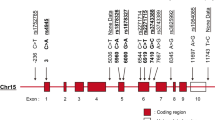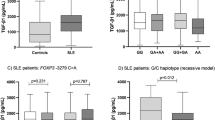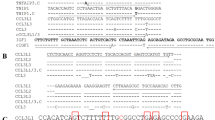Abstract
Differences in allelic distribution at loci surrounding the human HLA-DRB1 and tumor necrosis factor (TNF) genes have been observed in association with systemic lupus erythematosus (SLE). We investigated whether the association of HLA-DRB1*0301 (HLA-DR3) and TNF−308A with SLE could be attributed to polymorphic markers in the chromosomal region encompassed by HLA-DRB1 and HLA-C. Ninety-one consecutive Caucasian patients with SLE and 253 controls (organ donors) were typed for HLA-DRB1, microsatellites D6S1014, D6S273, TNFa, MIB, C1_2_5, and C1_3_2 and the single nucleotide polymorphism at position −308 in the promoter of TNF. The independent contribution of alleles to disease susceptibility was estimated by cross-tabulation and multivariate logistic regression. Possession of TNF−308A was associated with susceptibility to SLE (odds ratio [95% confidence interval], 3.70 [2.24–6.11]). This remained present after stratification on possession of HLA-DR3 (pooled odds ratio, 2.53 [1.37–4.70]). Stratification revealed a possible association of possession of C1_2_5*192 with protection from SLE beyond the effects of HLA-DR3 and TNF−308A. A gene dosage effect was observed for −308A only (homozygotes, 7.75 [3.01–20.0], heterozygotes, 3.15 [1.85–5.37]). In multivariate analysis, possession of HLA-DR3, TNF−308A, and C1_2_5*192 remained independently associated with susceptibility to SLE (2.58 [1.29–5.18], 2.76 [1.43–5.31], and 0.26 [0.10–0.66], respectively). The association of possession of TNF−308A with susceptibility to SLE cannot be attributed to linkage to HLA-DR3 alone, nor to other polymorphic markers in the vicinity of the TNF gene. Further loci that are independently associated with SLE might be in the vicinity of marker C1_2_5.
This is a preview of subscription content, access via your institution
Access options
Subscribe to this journal
Receive 6 digital issues and online access to articles
$119.00 per year
only $19.83 per issue
Buy this article
- Purchase on Springer Link
- Instant access to full article PDF
Prices may be subject to local taxes which are calculated during checkout
Similar content being viewed by others
References
Arnett FC, Goldstein R, Duvic M, Reveille JD Major histocompatibility complex genes in systemic lupus erythematosus,Sjogren’s syndrome, and polymyositis. (Review) Am J Med 1988 85 38–41
Hajeer AH, Dababneh A, Makki RF et al Different gene loci within the HLA-DR and TNF regions are independently associated with susceptibility and severity in Spanish rheumatoid arthritis patients Tissue Antigens 2000 55 319–325
Bali D, Gourley S, Kostyu DD et al Genetic analysis of multiplex rheumatoid arthritis families Genes Immun 1999 1 28–36
Obayashi H, Nakamura N, Fukui M et al Influence of TNF microsatellite polymorphisms (TNFa) on age-at-onset of insulin-dependent diabetes mellitus Hum Immunol 1999 60 974–978
Albuquerque RV, Hayden CM, Palmer LJ et al Association of polymorphisms within the tumour necrosis factor (TNF) genes and childhood asthma Clin Exp Allergy 1998 28 578–584
Sandberg-Wollheim M, Ciusani E, Salmaggi A, Pociot F An evaluation of tumor necrosis factor microsatellite alleles in genetic susceptibility to multiple sclerosis Mult Scler 1995 1 181–185
Louis E, Peeters M, Franchimont D et al Tumour necrosis factor (TNF) gene polymorphism in Crohn’s disease (CD): influence on disease behaviour? Clin Exp Immunol 2000 119 64–68
Wilson AG, de Vries N, Pociot F et al An allelic polymorphism within the human TNF-alpha promoter region is strongly associated with HLA A1, B8 and DR3 alleles J Exp Med 1993 177 557–560
Sanchez-Mazas A, Djoulah S, Busson M et al A linkage disequilibrium map of the MHC region based on the analysis of 14 loci haplotypes in 50 French families Eur J Hum Genet 2000 8 33–41
Gordon C, Ranges GE, Greenspan JS, Wofsy D Chronic therapy with recombinant tumor necrosis factor-alpha in autoimmune NZB/NZW F1 mice Clin Immunol Immunopathol 1989 52 421–434
Studnicka-Bencke A, Steiner G, Petera P, Smolen JS Tumour necrosis factor alpha and its soluble receptors parallel clinical disease activity in systemic lupus erythematosus Br J Rheum 1996 35 1067–1074
Sullivan KE, Wooten C, Schmeckpeper BJ, Goldman D, Petri MA A promoter polymorphism of tumor necrosis factor alpha associated with systemic lupus erythematosus in African-Americans Arthritis Rheum 1997 40 2207–2211
Bouma G, Crusius JB, Oudkerk Pool M et al Secretion of tumour necrosis factor α and lymphotoxin α in relation to polymorphisms in the TNF genes and HLA-DR alleles. Relevance for inflammatory bowel disease Scand J Immunol 1996 43 456–463
Huizinga TW, Westendorp RGJ, Bollen EL et al TNF-alpha promoter polymorphisms, production and susceptibility to multiple sclerosis in different groups of patients J Neuroimmunol 1997 72 149–153
Rudwaleit M, Tikly M, Khamashta M et al Interethnic differences in the association of tumor necrosis factor promoter polymorphisms with systemic lupus erythematosus J Rheumatol 1996 23 1725–1728
Stuber F, Udalova IA, Book M et al −308 tumor necrosis factor (TNF) polymorphism is not associated with survival in severe sepsis and is unrelated to lipopolysaccharide inducibility of the human TNF promoter J Inflamm 1995 46 42–50
Westendorp RG, Langermans JA, Huizinga TW et al Genetic influence on cytokine production and fatal meningococcal disease [published erratum appears in Lancet 1997; 349: 656] Lancet 1997 349 170–173
Rood MJ, van Krugten MV, van der Linden MW et al TNF−308A and HLA-DR3 alleles contribute independently to susceptibility to systemic lupus erythematosus Arthritis Rheum 2000 43 129–134
Singal DP, Li J, Ye M, Lei K D6S273 microsatellite polymorphism and susceptibility to rheumatoid arthritis Tissue Antigens 1998 52 353–358
d’Alfonso S, Colombo G, Della BS, Scorza R, Momigliano-Richiardi P Association between polymorphisms in the TNF region and systemic lupus erythematosus in the Italian population Tissue Antigens 1996 47 551–555
Hajeer AH, Worthington J, Davies EJ et al TNF microsatellite a2, b3 and d2 alleles are associated with systemic lupus erythematosus Tissue Antigens 1997 49 222–227
Tarassi K, Carthy D, Papasteriades C et al HLA-TNF haplotype heterogeneity in Greek SLE patients Clin Exp Rheumatol 1998 16 66–68
Jacob CO, Fronek Z, Lewis G, Hansen JA, McDevitt HO Heritable major histocompatibility complex class II-associated differences in production of tumor necrosis factor α: relevance to genetic predisposition to systemic lupus erythematosus Proc Natl Acad Sci USA 1990 87 1233–1237
Pociot F, Briant L, Jongeneel CV et al Association of tumor necrosis factor (TNF) and class II major histocompatibility complex alleles with the secretion of TNF-alpha and TNF-beta by human mononuclear cells: a possible link to insulin-dependent diabetes mellitus Eur J Immunol 1993 23 224–231
The MHC sequencing consortium Complete sequence and gene map of a human major histocompatibility complex Nature 1999 401 921–923
Dunckley H, Gatenby PA, Hawkins B, Naito S, Serjeantson SW Deficiency of C4A is a genetic determinant of systemic lupus erythematosus in three ethnic groups J Immunogenet 1987 14 209–218
Ochs HD, Rosenfeld SI, Thomas ED et al Linkage between the gene (or genes) controlling synthesis of the fourth component of complement and the major histocompatibility complex N Engl J Med 1977 296 470–475
Partanen J, Koskimies S, Johansson E C4 null phenotypes among lupus erythematosus patients are predominantly the result of deletions covering C4 and closely linked 21-hydroxylase A genes J Med Genet 1988 25 387–391
Schur PH, Marcus-Bagley D, Awdeh Z, Yunis EJ, Alper CA The effect of ethnicity on major histocompatibility complex complement allotypes and extended haplotypes in patients with systemic lupus erythematosus Arthritis Rheum 1990 33 985–992
Tappeiner G, Hintner H, Scholz S et al Systemic lupus erythematosus in hereditary deficiency of the fourth component of complement J Am Acad Dermatol 1982 7 66–79
Ulgiati D, Abraham LJ Comparative analysis of the disease-associated complement C4 gene from the HLA-A1, B8, DR3 haplotype Exp Clin Immunogenet 1996 13 43–54
Hartung K, Baur MP, Coldewey R et al Major histocompatibility complex haplotypes and complement C4 alleles in systemic lupus erythematosus. Results of a multicenter study J Clin Invest 1992 90 1346–1351
Wilson AG, Symons JA, McDowell TL, McDevitt HO, Duff GW Effects of a polymorphism in the human tumor necrosis factor alpha promoter on transcriptional activation Proc Natl Acad Sci USA 1997 94 3195–3199
Bendtzen K, Morling N, Fomsgaard A et al Association between HLA-DR2 and production of tumour necrosis factor alpha and interleukin 1 by mononuclear cells activated by lipopolysaccharide Scand J Immunol 1988 28 599–606
Somoskovi A, Zissel G, Seitzer U et al Polymorphisms at position −308 in the promoter region of the TNF-alpha and in the first intron of the TNF-beta genes and spontaneous and lipopolysaccharide-induced TNF-alpha release in sarcoidosis Cytokine 1999 11 882–887
Kroeger KM, Steer JH, Joyce DA, Abraham LJ Effects of stimulus and cell type on the expression of the −308 tumour necrosis factor promoter polymorphism Cytokine 2000 12 110–119
Sambrook J., Fritsch EF, Maniatis T Analysis and cloning of eukaryotic genomic DNA. In: Nolan C, Ford N, Ferguson M (eds) Molecular Cloning: A Laboratory Manual. Second edn Cold Spring Harbor Laboratory Press: Cold Spring Harbor, NY 1989 9 pp 9.16–9.17
Udalova IA, Nedospasov SA, Webb GC, Chaplin DD, Turetskaya RL Highly informative typing of the human TNF locus using six adjacent polymorphic markers Genomics 1993 16 180–186
Foissac A, Salhi M, Cambon-Thomsen A Microsatellites in the HLA region: 1999 update Tissue Antigens 2000 55 477–509
Zanelli E, Jones G, Pascual M et al The telomeric part of the HLA region predisposes to rheumatoid erthritis independent of the class II loci Hum Immunol 2001 62 75–84
Degli-Esposti MA, Griffiths MS, Daly LN et al Characterization of 4AOHW cell line panel including new data for the 10IHW panel Hum Immunol 1993 38 3–16
Verduyn W, Doxiadis II, Anholts J et al Biotinylated DRB sequence-specific oligonucleotides. Comparison to serologic HLA-DR typing of organ donors in eurotransplant Hum Immunol 1993 37 59–67
Woolf B On estimating the relation between blood group and disease Ann Hum Genet 1995 19 251
Acknowledgements
G Jones, W Verduyn (Immunohaematology and Blood Transfusion) and BA de Jong (Clinical Epidemiology) are gratefully acknowledged for their contribution. The authors are indebted to Dr BPC Koeleman (Immunohaematology and Blood Transfusion) and Dr FW Dekker (Clinical Epidemiology) for critical discussions.
Author information
Authors and Affiliations
Corresponding author
Rights and permissions
About this article
Cite this article
van der Linden, M., van der Slik, A., Zanelli, E. et al. Six microsatellite markers on the short arm of chromosome 6 in relation to HLA-DR3 and TNF−308A in systemic lupus erythematosus . Genes Immun 2, 373–380 (2001). https://doi.org/10.1038/sj.gene.6363794
Received:
Revised:
Accepted:
Published:
Issue Date:
DOI: https://doi.org/10.1038/sj.gene.6363794
Keywords
This article is cited by
-
Synergetic Interaction of HLA-DRB1*07 Allele and TNF-Alpha − 863 C/A Single Nucleotide Polymorphism in the Susceptibility to Systemic Lupus Erythematosus
Indian Journal of Clinical Biochemistry (2021)
-
Whole Exome Sequencing of Patients from Multicase Families with Systemic Lupus Erythematosus Identifies Multiple Rare Variants
Scientific Reports (2018)
-
Association of TNF-α promoter-308 A/G polymorphism with susceptibility to systemic lupus erythematosus: a meta-analysis
Rheumatology International (2012)
-
Meta-analysis of TNF-α promoter –308A/G polymorphism and SLE susceptibility in Asian populations
Rheumatology International (2011)
-
Genetic studies of systemic lupus erythematosus in Asia: where are we now?
Genes & Immunity (2009)



